= Mammillaria slevinii (Britton & Rose) Boed. in Boed.
Mammillarien-Vergleichs-Schluessel 44. 1933 Boed. Gray Herb. Card Cat., Issue 145.
Accepted Scientific Name: Mammillaria albicans (Britton & Rose) A.Berger
Kakteen (Berger) 308 (1929) (A.Berger)
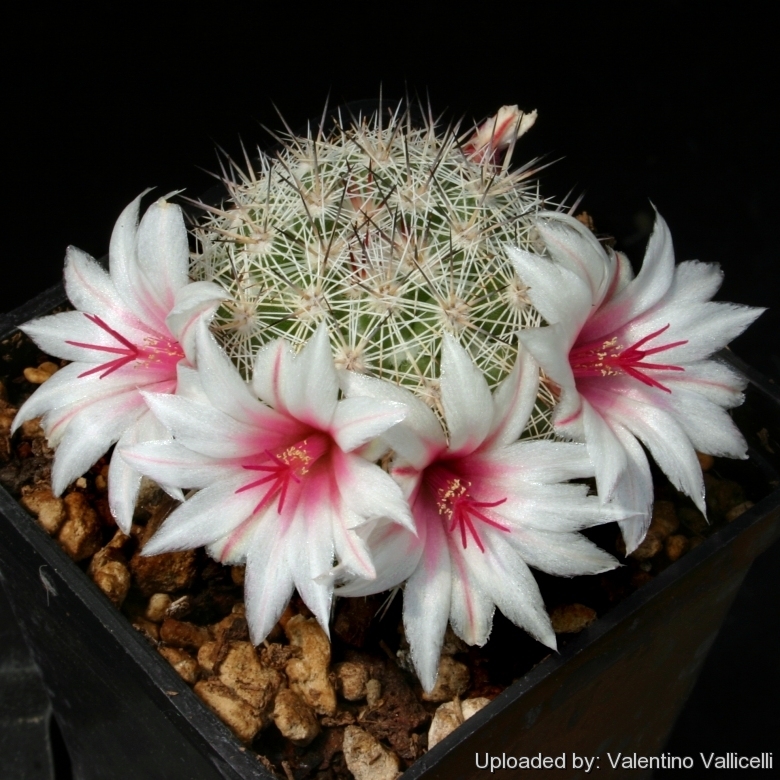
Mammillaria albicans f. slevinii (Mammillaria slevinii) Photo by: Valentino Vallicelli
Origin and Habitat: Baja California Peninsula and various islands, Mexico.
Altitude: 10 to 200 metres above sea level.
Habitat: It grows on arid granite-based soils and rocky hillsides.
Synonyms:
See all synonyms of Mammillaria albicans
back
Accepted name in llifle Database:Mammillaria albicans (Britton & Rose) A.BergerKakteen (Berger) 308 (1929)Synonymy: 8
back
Common Names include:
ENGLISH: Pincushion, Globe cactus
Description: Mammillaria sleviniiSN|5348]]SN|5352]] is synonymous of Mammillaria albicansSN|5352]]SN|5348]], they are are very similar, namely size and form of stems, shape of spines, flowers, etc. and the two plants are not readily distinguishable if not for the stems, simple or few branched (1-10 compared to 5-15 branched in M. albicans) moreover it has darker spines and the spine-areoles are not densely lanate.
Habit: Solitary or clustering cylindrical cactus entirely hidden under the many closely set spines.
Stem: Columnar, pale green, up to 10 or more cm tall, 5-6 cm in diameter branching basally
Tubercles: Broadly conical, without latex. The axil is woolly, especially in the flowering zone and bears few bristles, white with dark brown tips.
Spines: At top of plant pinkish below, with brown to blackish tips, on lower part of plant bleaching white.
Central spines: About 6, , a little longer and stouter than the radials, slightly spreading, white with brown tips, 8-10 mm long.
Radial spines: 14-21, white, 5 - 8 mm long.
Flowers: Around the top, white to pale pink, with pinkish mid-veins, up to 20 mm in diameter. Outer perianth-segments with a pinkish mid-rib. Inner perianth-segments white. Filaments pinkish. Style nearly white; stigma-lobes nearly white to purplish.
Blooming season: Summer (June to August).
Fruits: Club-shaped, red, 10-18 mm long.
Seeds: Nearly round, black, with a projection at base and a large basal hilum.
Subspecies, varieties, forms and cultivars of plants belonging to the Mammillaria albicans group
 Mammillaria albicans (Britton & Rose) A.Berger: produces clumps of 5-15 branches with cylindrical stems closely crowded and obscured by spines . Areoles densely white-woolly in youth.
Mammillaria albicans (Britton & Rose) A.Berger: produces clumps of 5-15 branches with cylindrical stems closely crowded and obscured by spines . Areoles densely white-woolly in youth. Mammillaria slevinii (Britton & Rose) Boed. in Boed.: has stems, simple or few branched, darker spines and the spine-areoles are not densely lanate.
Mammillaria slevinii (Britton & Rose) Boed. in Boed.: has stems, simple or few branched, darker spines and the spine-areoles are not densely lanate.
Bibliography: Major references and further lectures
1) Edward Anderson “The Cactus family” Timber Press, Incorporated, 2001
2) James Cullen, Sabina G. Knees, H. Suzanne Cubey "The European Garden Flora Flowering Plants: A Manual for the Identification of Plants Cultivated in Europe, Both Out-of-Doors and Under Glass" Cambridge University Press, 11/Aug/2011
2) David R Hunt; Nigel P Taylor; Graham Charles; International Cactaceae Systematics Group. "The New Cactus Lexicon" dh books, 2006
3) John Pilbeam “Mammillaria: the cactus file handbook” Cirio Publishing Services Ltd Dec/30,/1999
4) Nathaniel Lord Britton, Joseph Nelson Rose “Cactaceae: Descriptions and Illustrations of Plants of the Cactus Family” vol. 4 The Carnegie Institution of Washington, Washington 1923
5) León de la Luz, J.L., Hernández, H.M. & Gómez-Hinostrosa, C. 2013. Mammillaria albicans. In: IUCN 2013. "IUCN Red List of Threatened Species." Version 2013.2. <www.iucnredlist.org>. Downloaded on 19 January 2014.
6 )Reppenhagen, W. "Die Gattung Mammillaria nach dem heutigen Stand meines Wissens" Frankenthal 1988 (1989).
7) Li Zhenyu. "Cactaceae." In: Ku Tsuechih, ed., Fl. Reipubl. Popularis Sin. 52(1): 272-285 1999.
8) Craig, R. T. "The Mammillaria Handbook...." Pasadena 1945
9) Hunt, D. R. "A New Review of Mammillaria Names." Botley. [Reprinted from Bradleya 1-5, 1983-1987.]
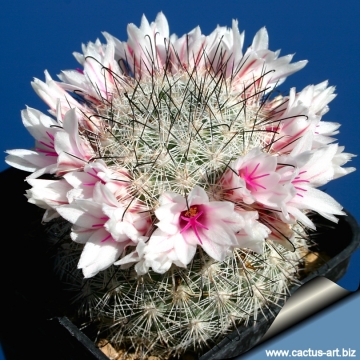 Mammillaria albicans f. slevinii (Mammillaria slevinii) Photo by: Cactus Art
Mammillaria albicans f. slevinii (Mammillaria slevinii) Photo by: Cactus Art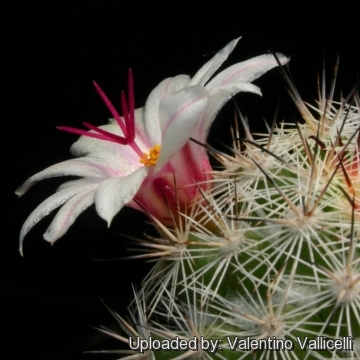 Mammillaria albicans f. slevinii (Mammillaria slevinii) Photo by: Valentino Vallicelli
Mammillaria albicans f. slevinii (Mammillaria slevinii) Photo by: Valentino Vallicelli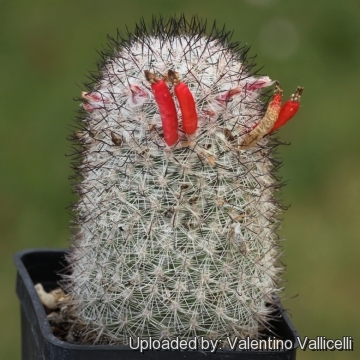 Mammillaria albicans f. slevinii (Mammillaria slevinii) Photo by: Valentino Vallicelli
Mammillaria albicans f. slevinii (Mammillaria slevinii) Photo by: Valentino Vallicelli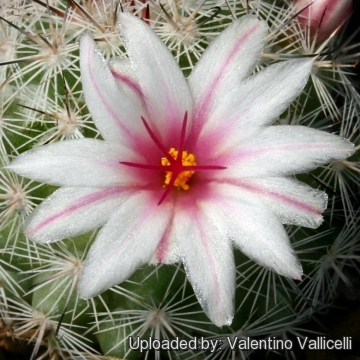 Mammillaria albicans f. slevinii (Mammillaria slevinii) Photo by: Valentino Vallicelli
Mammillaria albicans f. slevinii (Mammillaria slevinii) Photo by: Valentino Vallicelli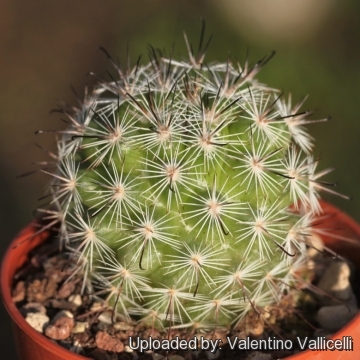 Mammillaria albicans f. slevinii (Mammillaria slevinii) Photo by: Valentino Vallicelli
Mammillaria albicans f. slevinii (Mammillaria slevinii) Photo by: Valentino Vallicelli Mammillaria albicans f. slevinii (Mammillaria slevinii) Photo by: Cactus Art
Mammillaria albicans f. slevinii (Mammillaria slevinii) Photo by: Cactus Art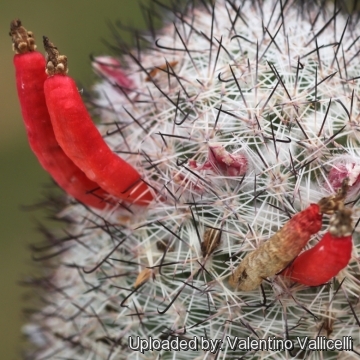 Mammillaria albicans f. slevinii (Mammillaria slevinii) Photo by: Valentino Vallicelli
Mammillaria albicans f. slevinii (Mammillaria slevinii) Photo by: Valentino VallicelliSend a photo of this plant.The gallery now contains thousands of pictures, however it is possible to do even more. We are, of course, seeking photos of species not yet shown in the gallery but not only that, we are also looking for better pictures than those already present.
Read More... Cultivation and Propagation: It is slow-growing, and not especially easy to grow. Use pot with good drainage and a very porous mineral-based potting mix. Potted plants are quite wet-sensitive, especially in light of its small root system. Water sparingly during the growing season, keep very dry in winter. Feed with a high potassium fertilizer in summer.
Usually it is recommended to overwinter this plant in a bright and warm greenhouse with at least 8-10° C, but it has proved to be quite frost resistant (if kept dry, it's hardy as low as -5° C). Strong light is required for flowering.
Some plants will offset readily, and clumps can be produced in a very few years.
Propagation: Direct sow after last frost, or use cuttings.

















